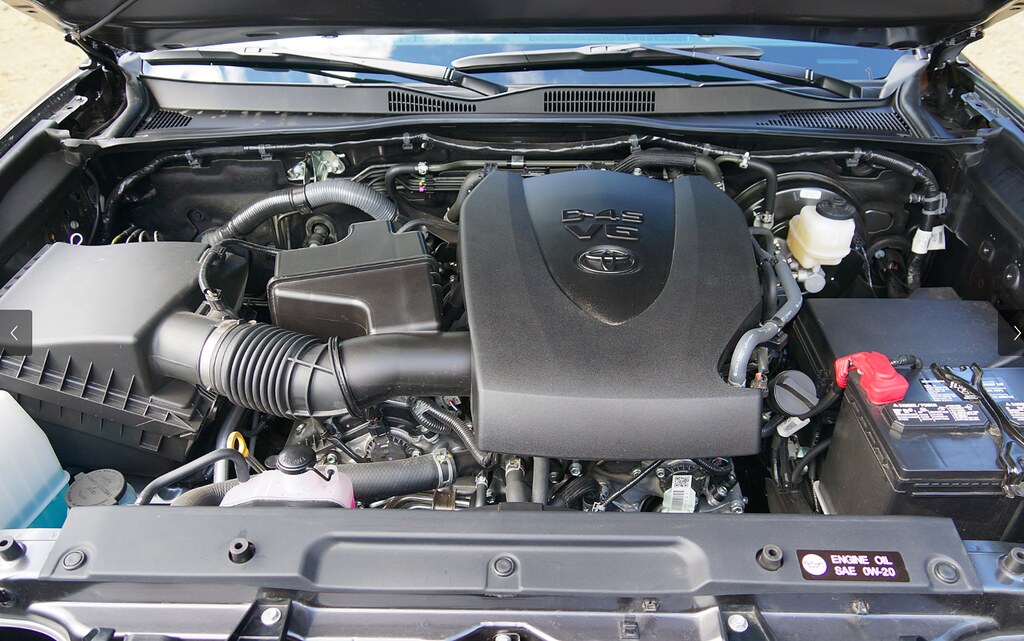The introduction of the redesigned 2016 Toyota Tacoma seems to have been more cloaked in secrecy than any new-vehicle release I can recall. Details have trickled out of the company slower than Hillary’s emails. (Just hand over the server, Toyota!)
One of the biggest questions concerned the optional V6 engine. We knew it would be new, but information regarding power and other specifications was not to be had. Now at last we have details.
Basically, the 2GR-FKS is a 3.5-liter (3,456 cc) 60º V6, with double overhead cams and four valves per cylinder, derived from the engine in the 2015 Lexus GS. Bore and stroke are 94 and 83mm. It produces 278 horsepower and 265 lb.ft. of torque—up 42 hp and, er . . . down one lb.ft. from the previous 4.0-liter 1GR-FE V6. Its most intriguing design feature is the fuel injection system, which combines port (fuel injected into the intake manifold just above the intake valve) and direct (fuel injected directly into the combustion chamber) operation. At low speeds, the system can combine both injectors or use one, as needed, to provide stable cold starts, prompt response, and low emissions. At high speeds and high loads, the system switches to direct injection: Each cylinder is equipped with an extremely high-pressure injector that sprays atomized fuel in a horizontal fan-shaped pattern into the combustion chamber after the piston has begun its compression stroke. This promotes a complete burn, reduces detonation, and cools the intake charge, enabling a very high 11.8:1 compression ratio while retaining the ability to run on regular gas—thank you Toyota! (Direct injection is promoted as the latest in high-tech engine wizardry; in fact the 1954 Mercedes-Benz 300SL had it, albeit with mechanical rather than electronic control.)
Toyota refers to the 2GR-FKS as an Atkinson cycle engine, which technically it is not. The original Atkinson-cycle engine used a complex multi-piece connecting rod that enabled a complete intake, compression, combustion, and exhaust cycle to be accomplished in one turn of the crankshaft (rather than two as in a “normal” Otto-cycle engine). It also, cleverly, allowed the intake/compression stroke to be shorter than the combustion/exhaust stroke. The Toyota system uses a much simpler modified Otto-cycle process in which the intake valve is held open for a period after the piston has begun its compression stroke, allowing some ‘leakage’ back into the intake manifold. This reduces the effective compression ratio and charge volume—which seems like a bad thing—but retains the full expansion volume of the piston’s combustion stroke. Simply put, this allows the combustion process to extract more energy from the intake charge, increasing efficiency and fuel economy. (There is a good YouTube video here.) However, there is a downside: Since this process is compressing less fuel and air per stroke than a standard Otto-cycle engine, the power density is somewhat lower. I’m guessing (yes, guessing!) that given the variable valve timing capabilities of Toyota’s VVT-i cam system, the “Atkinson cycle” effect can be varied or even turned off as required by engine speed and load, but I’ve not yet confirmed this.
Internals of the 2GR-FKS engine are of superior quality. Block and heads are aluminum, of course. Both the crankshaft and connecting rods are forged. The cams are driven by a long-life chain rather than a belt, and the rocker arms ride on needle bearings. Iridium-tipped spark plugs are good for 60,000 miles, and have a deep threaded section, which allows thicker material in the head at that point, which in turn allows coolant passages to be routed closer to the combustion chambers. Externally, the exhaust manifolds and pipe are stainless steel.
The aim of all this, of course, is the holy grail of improved power with lower fuel consumption. Indeed, the city and highway economy ratings for the 2016 Tacoma are better than those of the outgoing model, despite the increased horsepower. However, they still lag behind the figures for the 3.6-liter V6 in the new Chevrolet Colorado—which also boasts 305 horsepower. (And—sigh—let's not even mention that truck's optional 2.8-liter Duramax turbodiesel.) We’ll have to see how real-world figures compare to the EPA’s estimates.
One more item is worth mentioning. When I heard the new Tacoma’s engine was to be a 3.5 liter, I wondered aloud if its torque peak would be at an even higher engine speed than the already too-high 4,000 rpm of the outgoing 4.0-liter. Sure enough: The 2GR-FKS delivers its 265 lb.ft. at a stratospheric 4,600 rpm. Compare that to the 4,000-rpm peak in the Colorado—or the 2,000-rpm torque peak of the inline six-cylinder in my old FJ40. Those few who choose the manual transmission and decide to haul a loaded trailer with their new Tacoma are going to be doing some serious revving to get under way. As my friend and ace Toyota mechanic Bill Lee said when we were discussing this, “I love doing clutch jobs.”


